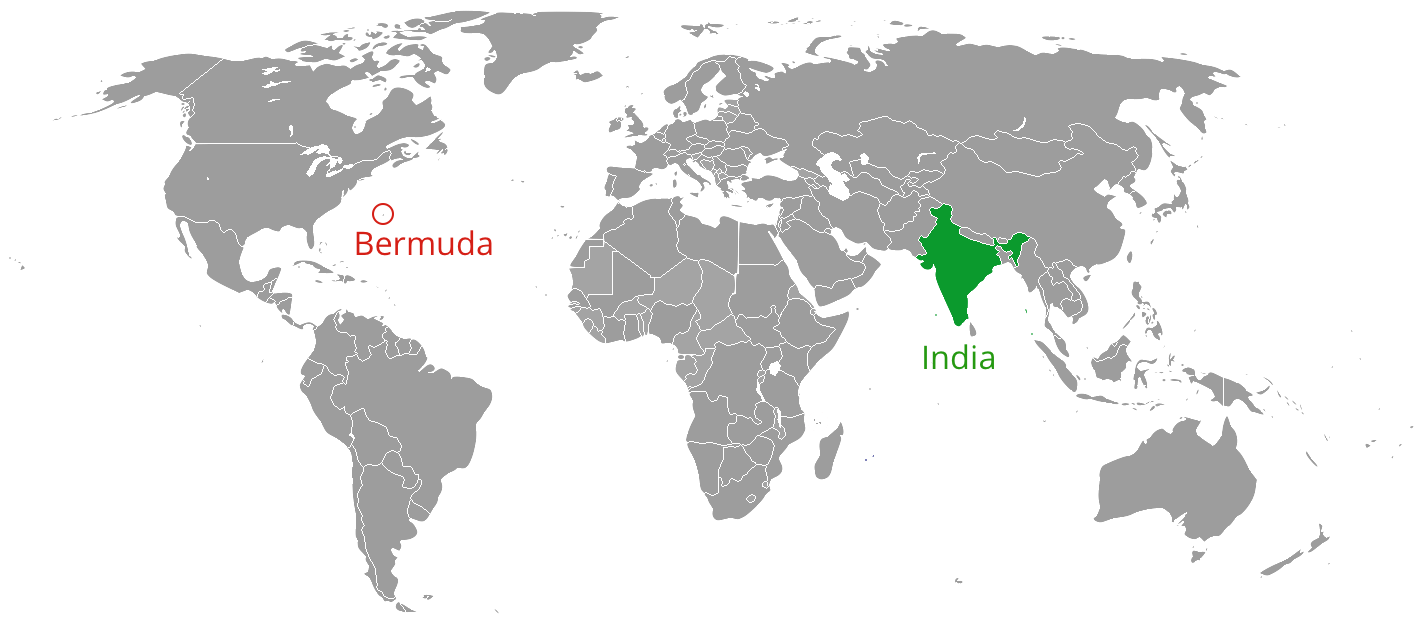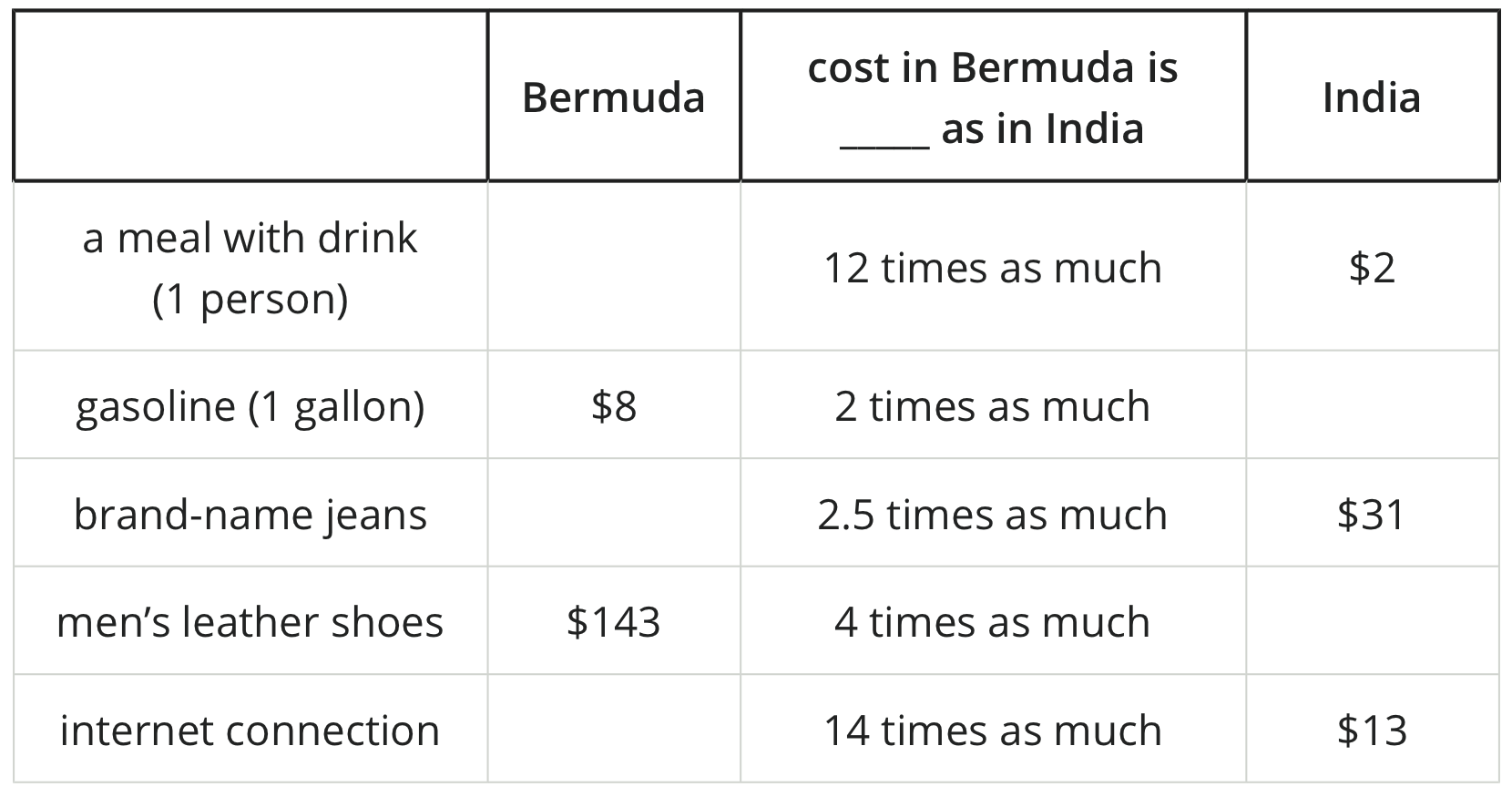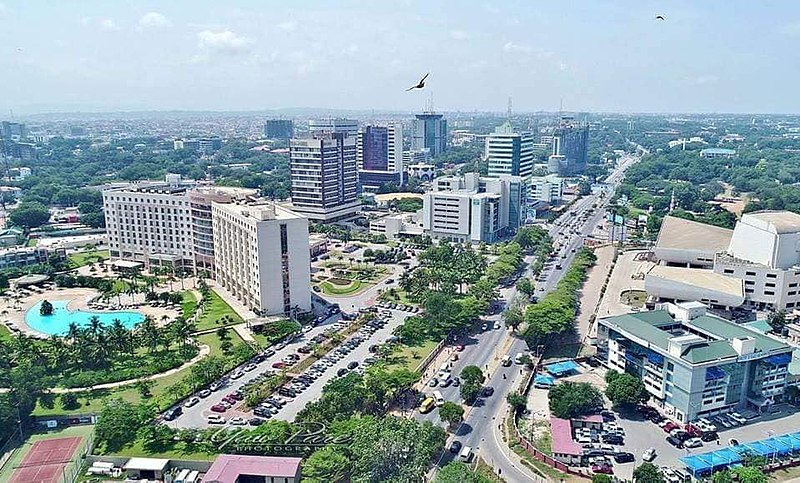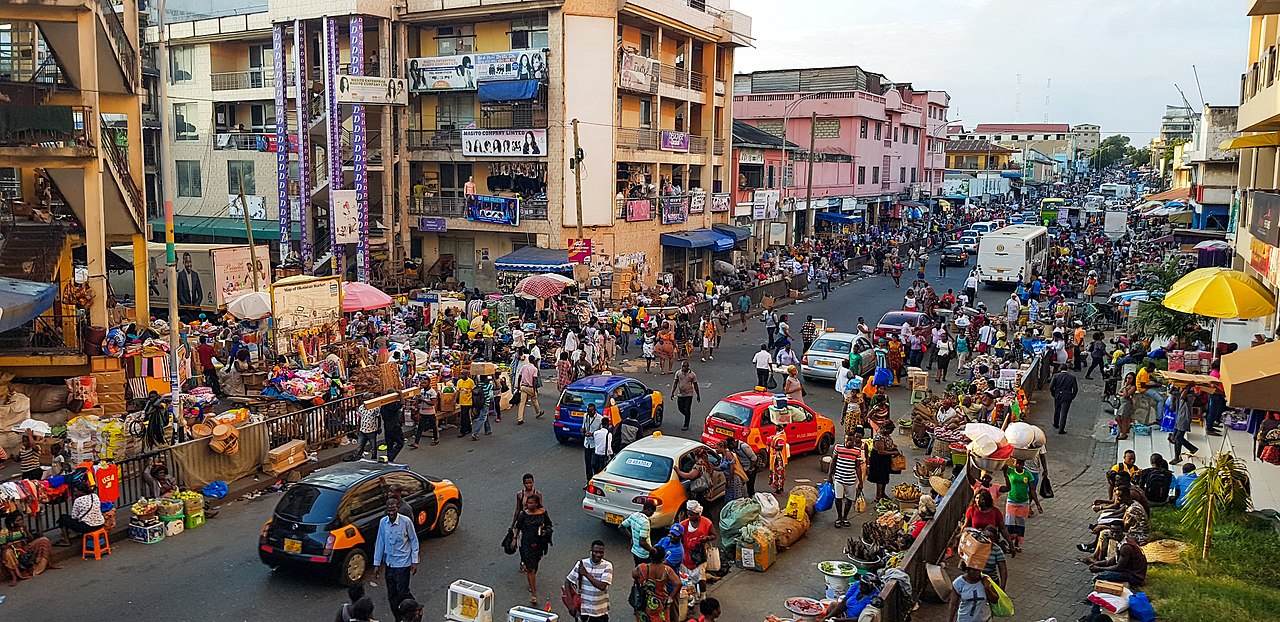Lesson 7
Solve Multiplicative Comparison Problems
Warm-up: Notice and Wonder: Two Cities (10 minutes)
Narrative
The purpose of this warm-up is to elicit observations about differences in costs of living in different parts of the United States. It prepares students to look for and make sense of multiplicative comparisons later in the lesson. It also helps elicit what students know about how the different costs may be different depending on where you live.
Students may notice and wonder many things about the data in the table and both additive and multiplicative comparisons are likely to come up. Some students may note that an item costs “some dollars more” in San Francisco than in Fort Wayne, while others may say it costs “some number of times as much” based on the quantities or their estimation of the quantities. In the synthesis, focus student discussion on additive and multiplicative comparison.
Launch
- Groups of 2
- Display the table.
Activity
- “What do you notice? What do you wonder?”
- 1 minute: quiet think time
- 1 minute: partner discussion
- Share and record responses.
Student Facing
What do you notice? What do you wonder?
| San Francisco, CA | Fort Wayne, IN | |
|---|---|---|
| population | 805,235 | 253,691 |
| milk (1 gallon) | \$4.45 | \$2.14 |
| bread (1 loaf) | \$3.54 | \$1.82 |
| gasoline (1 gallon) | \$3.70 | \$2.42 |
| movie ticket | \$15 | \$12 |
| internet connection (1 month) | \$70 | \$50 |
| rent for a 3 bedroom apartment in the city center (1 month) | \$6,000 | \$1,500 |
| cost of a house | \$1,400,000 | \$160,000 |
Student Response
For access, consult one of our IM Certified Partners.
Activity Synthesis
- “How could you compare the cost for renting an apartment in San Francisco to the cost in Fort Wayne? How could you use multiplication to compare the costs?”
- As needed, “About how many more times as much is the cost of a house in San Francisco compare to the cost of a house in Fort Wayne?”
- “The prices of the things you need to live, like food, clothing, and shelter, are called the cost of living. The cost of living can be very different depending on where in the world you live. Today we are going to compare the cost of living in different places around the world.”
Activity 1: The Most and Least Expensive (20 minutes)
Narrative
This activity prompts students to use multiplicative comparison to determine the cost of different living expenses in Bermuda and in India. Students use these costs to interpret and solve a multi-step problem. The multi-step problem can be solved in more than one way. Students might use multiplication or division. They may also choose to estimate rather than perform each calculation. Encourage students to use the Three Reads routine as needed to solve problems.
When finding the missing prices in the table, students also have an opportunity to reason about how to find a value that is 2.5 times as much. Students are not expected to multiply whole numbers by decimals in grade 4, but may use their understanding of decimal notation and decimal fractions to estimate the cost by doubling the price in India and adding half the price or by reasoning that 2.5 is close to 3.
Advances: Reading, Representing.
Launch
- Groups of 2
- “We saw one example of how the same items can vary a lot in cost depending on where you live in the United States. Let’s look at the costs of some other things in two different countries—one known to be very expensive and the other known to be inexpensive.”
Activity
- 5 minutes: independent work time on the first question
- Monitor for students who use the multiplication or division algorithm, draw diagrams, write equations, or use estimation to find the missing values.
- Pause for a discussion. Select students to share their responses and reasoning for finding the costs in the table.
- Highlight that to find the missing cost in Bermuda, we can multiply the cost in India by the number in the middle column, and to find the cost in India, we divide the cost in Bermuda by the number in the middle column.
- 4 minutes: independent work time on the second question
- 4 minutes: partner discussion
Student Facing

-
The table shows how prices of some things in the two countries compare. Estimate or calculate the missing costs and complete the table.

-
In India, rent for a 1-bedroom apartment outside of a city center costs about \$76 per month. A similar apartment in Bermuda costs 23 times as much.
Utilities (electric, gas, water, and heating) for a small apartment costs about \$27 per month in India and 7 times as much in Bermuda.
If a person earns \$2,000 per month, can they afford to pay rent and utilities in Bermuda?
Student Response
For access, consult one of our IM Certified Partners.
Activity Synthesis
- Select students to share their responses and strategies for how they determined if they can afford to live a month in Bermuda with \$2,000.
Activity 2: The Cost of Living (15 minutes)
Narrative
In this activity, students continue to solve multiplicative comparison problems in the context of cost of living. In addition to using multiplicative comparison to find a greater or smaller unknown value, students also find an unknown multiplier.
Students also work with larger numbers. Some questions (about the costs of utilities, for instance) could be answered by dividing one multi-digit number by another (for instance, \(153 \div 73\)), but students are not expected to do this in grade 4. Instead, they may reason in terms of multiplication and by using estimation. For example, they may reason that \(73 \times 2\) is 146 or \(75 \times 2\) is 150, so the missing multiplier must be close to 2. Encourage students to use the Three Reads routine as needed to solve problems.
Supports accessibility for: Conceptual Processing, Organization, Attention
Launch
- Groups of 2
- “Have you ever traveled to another place far away? Do you know a friend or family member who has?”
- Share responses.
- “In this activity, you will compare the typical cost for things in the United States to the cost for the same things in Ghana.”
Activity
- 4 minutes: independent work time on the first question
- 2 minutes: partner discussion
- Monitor for the different ways students make estimates, for example, whether they:
- opt to multiply or divide
- use exact or rounded numbers
- round before computing or compute before rounding
- Pause for a brief discussion. Select students to share their responses and reasoning for finding the costs in the table.
- 4 minutes: independent work time on the second question
- 2 minutes: partner discussion
- Monitor for different strategies students use to find how many months of rent the family could afford in each country, including strategies based on estimation.
Student Facing
The cost of living in the United States is higher than in Ghana.


-
The table shows how the prices of some other things in the two countries compare. Estimate or calculate the missing information in the table.

-
Suppose a family has \$3,000 for housing and wants a 1-bedroom apartment outside of a city center. With that amount of money, how many months of rent can they afford in:
- the United States? Explain or show your reasoning.
- Ghana? Explain or show your reasoning.
Student Response
For access, consult one of our IM Certified Partners.
Activity Synthesis
- See lesson synthesis.
Lesson Synthesis
Lesson Synthesis
“Today we compared the cost of living in several countries.”
“What are the different ways you compared the prices and the cost of living between two different places in the activities today?” (We used multiplication to describe how many times as much the cost of living was. We used multiplication and division to determine a price in one country. We also used addition and subtraction to check to see how much of something we could buy in one country compared to another.)
“When would it be important to compare the cost of living in one place compared to another?” (If you were planning a trip, you might want to plan for how much things will cost. If you are moving to a new place.)
“What questions do you have about cost of living that you would like to learn more about?”
Cool-down: Restaurant Budget (5 minutes)
Cool-Down
For access, consult one of our IM Certified Partners.